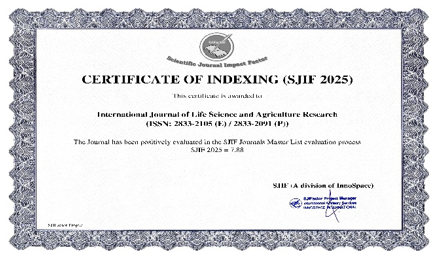Identification of a Mutant Resistant to Acetolactate Synthase Inhibitor Herbicides Through Mutagenesis in Camelina sativa (L.) Crantz
DOI:
https://doi.org/10.55677/ijlsar/V03I6Y2024-02Keywords:
.Abstract
Herbicide tolerance in crops is an effective way to manage weeds and maintain stable yield. Camelina sativa (L.) Crantz is commercially grown for the biofuel and bio-industrial markets. Having tolerance to widely used herbicide products can improve a variety’s yield potential due to minimizing yield risks from weed competition. In this study, we tested the time of treatments with EMS and created an EMS-induced population from Camelina line ‘Ames1043’. A mutant, namely Nfld001, was found in the field after spraying sulfonylurea (SU) herbicide Harmony™. The M2 mutant and the M3 population were tested by KASP assay and further confirmed on Chr09 by sequencing the ALS gene region covering the mutation. The mutation happened at the 197 amino acid with a transition from CCT to CTT causing the change of proline to leucine in the ALS protein. The mutant will be used for breeding camelina lines with better weed management and stable yield.
References
Bernasconi, P., Woodworth, A. R., Rosen, B. A., Subramanian, M. V., Siehl, D. L. 1995. A naturally occurring point mutation confers broad range tolerance to herbicides that target acetolactate synthase. Journal of Biological Chemistry 270: 17381 - 1738.
Büchsenschütz-Nothdurft A., Schuster A., Friedt W. 1998. Breeding for modified fatty acid composition via experimental mutagenesis in Camelina sativa (L.) Crantz. Ind. Crops Prod. 7: 291-295
Chaudhary J., Deshmukh R., Sonah H. 2019. Mutagenesis Approaches and Their Role in Crop Improvement. Plants (Basel). 8(11):467. doi: 10.3390/plants8110467. PMID: 31683624, PMCID: PMC6918138.
Chen L., Duan L., Sun M., Yang Z., Li H., Hu K., et al. 2023. Current trends and insights on EMS mutagenesis application to studies on plant abiotic stress tolerance and development. Front. Plant Sci. 13. doi: 10.3389/fpls.2022.1052569
Comai, L., Henikoff, S. 2006. TILLING: practical single-nucleotide mutation discovery. Plant J. 45, 684–694.
Fartyal, D., Agarwal, A., James, D. et al. 2018. Developing dual herbicide tolerant transgenic rice plants for sustainable weed management. Sci Rep 8, 11598. https://doi.org/10.1038/s41598-018-29554-9
Gutteridge S., Thompson M.E., Ort O., Shaner D.L., Stidham M., Singh B., Tan S., Johnson T.C., Mann R.K., Schmitzer P.R., et al. 2012. Acetohydroxyacid synthase inhibitors (AHAS/ALS) Mod. Crop Prot. Compd. Second Ed. doi: 10.1002/9783527699261.ch2.
Hanson, B.D., Park, K.W., Mallory-Smith, C.A., Thill, D.C. 2010. Resistance of Camelina microcarpa to acetolactate synthase inhibiting herbicides. Weed Res. 2010, 44, 187–194.
Hernandez, M.J., R. Leon, A. J. Fischer, M. Gebauer, R. Galdames, and R. FIgueroa. 2015. Target-Site Resistance to Nicosulfuron in Johnsongrass (Sorghum halepense) from Chilean Corn Fields. Weed Science 63: 631 - 640.
Hubert, S.H., Craine, W., Pan, W.L. 2018. Registration of WA-HT1, a camelina line with resistance to residual levels of ALS inhibitor herbicides. J. Plant Regist. 12: 253–256.
Kolkman, J. M., Slabaugh, M. B., Bruniard, J. M., Berry, S., Bushman, B. S., Olungu, C., Maes, N., Abratti, G., Zambelli, A., Miller, J. F., Leon, A., Knapp, S. J. 2004. Acetohydroxyacid synthase mutations conferring resistance to imidazolinone or sulfonylurea herbicides in sunflower. Theoretical and Applied Genetics 109: 1147 - 1159.
Laplante, J., I. Rajcan, and F. J. Tardif. 2009. Multiple allelic forms of acetohydroxyacid synthase are responsible for herbicide resistance in Setaria viridis. Theoretical and Applied Genetics 119: 577 - 585.
Lee Hart. 2018. New non-GMO canola variety for the market. Grain News. February 8, 2018
Massa, D., B. Krenz, And R. Gerhards. 2011. Target-site resistance to ALS-inhibiting herbicides in Apera spica-venti populations is conferred by documented and previously unknown mutations. Weed Research 51: 294 – 303.
Mcnaughton, K. E., E. Lee A., And F. Tardif J. 2001. Mutations in the ALS gene conferring resistance to group II herbicides in redroot pigweed (Amaranthus retroflexus) and green pigweed (A. powellii). Weed Science Society of America Abstracts 41: 97.
Neumann, N.G., Nazarenus, T.J., Aznar-Moreno, J.A., Rodriguez-Aponte, S.A., Mejias Veintidos, V.A., Comai, L.et al. 2021. Generation of camelina mid-oleic acid seed oil by identification and stacking of fatty acid biosynthetic mutants. Industrial Crops and Products.159: 113074.
Saari, L. L., Cotterman, J. C., Primiani, M. M. 1990. Mechanism of sulfonylurea herbicide resistance in the broadleaf weed, Kochia scoparia. Plant Physiology 93: 55 - 61.
Singh, S., V. Singh, R. A. Salas-Perez, M. V. Bagavathiannan, A. Lawton-Rauh, and N. Roma-Burgos. 2019. Target-site mutation accumulation among ALS inhibitor-resistant Palmer amaranth. Pest Manag Sci. 75: 1131 - 1139.
Tamura K., Stecher G., and Kumar S. 2021. MEGA11: Molecular Evolutionary Genetics Analysis version 11. Molecular Biology and Evolution (https://doi.org/10.1093/molbev/msab120)
Tranel, P.J., Wright, T.R, and Heap, I.M. 2024. Mutations in herbicide-resistant weeds to Inhibition of Acetolactate Synthase. Online http://www.weedscience.com. 3/18/2024.
Walsh D.T., Babiker E.M., Burke I.C., Hulbert S.H. 2012. Camelina mutants resistant to acetolactate synthase inhibitor herbicides. Mol Breed. 2012 30:1053-63.
Walsh, D.T., Babiker, E.M., Burke, I.C. et al. 2012. Camelina mutants resistant to acetolactate synthase inhibitor herbicides. Mol Breeding 30, 1053–1063. https://doi.org/10.1007/s11032-011-9689-0
Wang Z.N. 2007. Marker development and gene identification for blackleg resistance in canola (Brassica napus L.). University of Manitoba.
Werle, R., K. Begcy, M. K. Yerka, J. P. Mower, I. Dweikat, A. J. Jhala, and J. L. Lindquist. 2017. Independent Evolution of Acetolactate Synthase–inhibiting Herbicide Resistance in Weedy Sorghum Populations across Common Geographic Regions. Weed Science 65: 164 - 176.
Whaley, C. M., Wilson, H. P., Westwood, J. H. 2007. A new mutation in plant Als confers resistance to five classes of Als-inhibiting herbicides. Weed Science 55: 83 - 90.
Woodworth, A. P., P. Bernasconi, M. Subramanian, And B. Rosen. 1996. A second naturally occurring point mutation confers broad-based tolerance to acetolactate synthase inhibitors. Plant Physiology 111: S105.
Xin, Z., Li Wang, M., Barkley, N.A. et al. 2008. Applying genotyping (TILLING) and phenotyping analyses to elucidate gene function in a chemically induced sorghum mutant population. BMC Plant Biol 8: 103. https://doi.org/10.1186/1471-2229-8-103
Downloads
Published
Issue
Section
License
Copyright (c) 2024 International Journal of Life Science and Agriculture Research

This work is licensed under a Creative Commons Attribution 4.0 International License.












